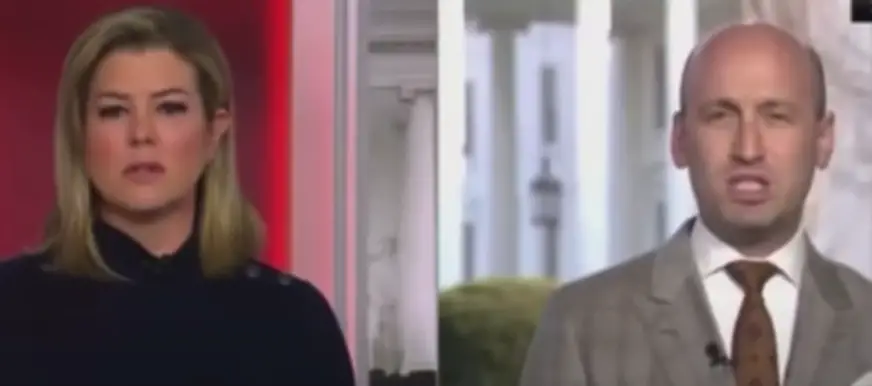NOTE:VIDEO AT THE END OF ARTICLE.
Stephen Miller and CNN’s Brianna Keilar Clash Over DOGE Structure in Heated Interview
A detailed analysis of the contentious February 18, 2025 interview that highlighted tensions between the Trump administration and mainstream media
Overview of the Interview
On February 18, 2025, Stephen Miller, President Trump’s White House Deputy Chief of Staff for Policy, appeared on CNN for what became a highly contentious 13-minute interview with anchor Brianna Keilar. The discussion centered primarily on the Department of Government Efficiency (DOGE) and its organizational structure, leading to a heated exchange that has since garnered significant attention across political media circles.
The interview highlighted ongoing tensions between the Trump administration and mainstream media outlets, while also raising questions about media preparation and understanding of government operations. The exchange became particularly notable for its breakdown in communication and the visible frustration displayed by both participants.
Background on DOGE
Before examining the interview details, it’s important to understand the context surrounding DOGE. The Department of Government Efficiency represents a restructuring of what was previously known as the US Digital Services, now operating as a federal agency reporting directly to the Executive Office of the President. This reorganization has been a key focus of the current administration’s efforts to streamline government operations and reduce federal spending.
The department’s mission involves identifying inefficiencies in government spending, eliminating waste, and implementing technology-driven solutions to improve federal operations. Elon Musk has been appointed as an advisor to the department, though his exact role and authority have been subjects of ongoing discussion in political and media circles.
The Interview Breakdown
Initial Questions About Leadership Structure
The interview began with Keilar questioning Miller about DOGE’s leadership structure. When asked who was in charge of the department, Miller provided a straightforward response: “The President of the United States.” This answer appeared to confuse Keilar, who followed up by asking whether President Trump served as the administrator of DOGE.
Miller attempted to clarify the governmental structure, explaining that “DOGE is what was formerly US Digital Services. It’s an agency of the federal government that reports to the Executive Office of the President.” This explanation aimed to establish the clear chain of command within the federal hierarchy.
Confusion Over Elon Musk’s Role
One of the interview’s most discussed moments occurred when Keilar asked, “Does Elon Musk know he’s not in charge of DOGE?” This question suggested a fundamental misunderstanding of advisory roles within government structure and the distinction between appointed advisors and department heads.
Miller responded with patience, explaining the basic principles of government organization: “The President appoints advisors, including Elon, including myself, including all the other staff here at the White House, and then those staff, in turn, execute the President’s commands and directions to all the agencies of the federal government. This is how democracy works.”
This exchange highlighted the complexity of explaining governmental hierarchies and the distinction between advisory roles and direct operational control. Miller’s response emphasized the constitutional framework that places ultimate executive authority with the President.
Escalating Tensions
As the interview progressed, tensions became increasingly apparent. At one point, Keilar attempted to moderate the discussion by stating, “Steven, let’s calm down. We’re not having a debate.” Miller’s response reflected his frustration with the line of questioning: “You are trying to debate me, and I will be as excited as I want to be about the fact that we are saving Americans billions of dollars and ending the theft and waste and grift and corruption.”
This exchange revealed the underlying tension between Miller’s desire to discuss policy achievements and Keilar’s focus on structural and organizational questions. The disconnect between the interviewer’s approach and the interviewee’s messaging became increasingly evident.
Questions About Data Access and Privacy
The interview also addressed concerns about DOGE’s access to taxpayer information. Keilar inquired whether department employees could access private taxpayer data, including bank account information. Miller clarified that DOGE employees would not have access to any information beyond what “any other appropriately authorized federal employee” could access.
This portion of the interview touched on legitimate privacy concerns while also demonstrating the ongoing need for clear communication about government data handling procedures. The exchange highlighted the importance of transparency in government operations while maintaining appropriate security protocols.
Media Analysis and Reactions
Professional Conduct and Interview Dynamics
The interview has been analyzed extensively for its demonstration of interview dynamics and professional conduct under pressure. Media professionals have noted several aspects of the exchange that merit discussion:
Preparation and Research: The interview raised questions about the importance of thorough preparation when covering complex government structures and policies. Understanding the basic organizational framework of federal agencies is crucial for conducting effective interviews.
Communication Strategies: Both participants employed different communication strategies, with Miller focusing on policy achievements and governmental structure, while Keilar pursued questions about organizational clarity and potential conflicts of interest.
Emotional Control: The visible tension and emotional responses during the interview highlighted the challenges of maintaining professional composure during contentious political discussions.
Broader Implications for Political Media
This interview has become part of a larger conversation about the relationship between government officials and media outlets. Several key themes have emerged from the discussion:
Government Transparency: The exchange underscored the importance of clear communication about government operations and the roles of various officials and advisors.
Media Accountability: Questions have been raised about media preparation and the responsibility of journalists to understand the subjects they’re covering before conducting interviews.
Political Polarization: The heated nature of the exchange reflects broader trends in political discourse and the challenges of conducting substantive policy discussions in a polarized environment.
Policy Context and DOGE’s Mission
Beyond the interview drama, the discussion highlighted important policy questions about government efficiency and reform. DOGE’s mission to identify and eliminate government waste represents a significant undertaking that affects multiple federal agencies and programs.
The department’s work involves analyzing government spending patterns, identifying redundant programs, and implementing technology solutions to improve efficiency. These efforts have the potential to save taxpayers significant amounts of money while improving government services.
Understanding the scope and authority of DOGE is important for evaluating its potential impact on federal operations. The department’s reporting structure and relationship to other agencies will likely influence its effectiveness in achieving stated goals.
Lessons Learned and Moving Forward
The Miller-Keilar interview offers several lessons for both government officials and media professionals:
Clear Communication: The importance of establishing clear definitions and understanding before proceeding with complex policy discussions cannot be overstated.
Professional Preparation: Thorough research and preparation are essential for conducting effective interviews on complex topics.
Constructive Dialogue: Finding ways to maintain constructive dialogue even during disagreements is crucial for informed public discourse.
Conclusion
The February 18, 2025 interview between Stephen Miller and Brianna Keilar serves as a case study in political communication challenges and media-government relations. While the exchange was marked by tension and miscommunication, it also highlighted important questions about government structure, accountability, and the role of media in explaining complex policy issues to the public.
Moving forward, both government officials and media professionals can learn from this exchange to improve the quality of public discourse and ensure that important policy discussions are conducted in ways that inform rather than confuse the public. The success of democratic institutions depends on effective communication between all stakeholders, making these lessons particularly relevant for ongoing political coverage and government transparency efforts.

Ethan Blake is a skilled Creative Content Specialist with a talent for crafting engaging and thought-provoking narratives. With a strong background in storytelling and digital content creation, Ethan brings a unique perspective to his role at TheArchivists, where he curates and produces captivating content for a global audience.
Ethan holds a degree in Communications from Zurich University, where he developed his expertise in storytelling, media strategy, and audience engagement. Known for his ability to blend creativity with analytical precision, he excels at creating content that not only entertains but also connects deeply with readers.
At TheArchivists, Ethan specializes in uncovering compelling stories that reflect a wide range of human experiences. His work is celebrated for its authenticity, creativity, and ability to spark meaningful conversations, earning him recognition among peers and readers alike.
Passionate about the art of storytelling, Ethan enjoys exploring themes of culture, history, and personal growth, aiming to inspire and inform with every piece he creates. Dedicated to making a lasting impact, Ethan continues to push boundaries in the ever-evolving world of digital content.
